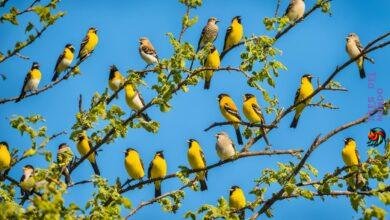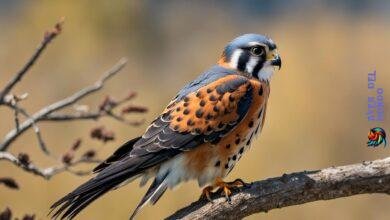Did you know that the United States is home to over 900 bird species? From colorful warblers to majestic raptors, the vast landscapes of the USA provide a haven for a diverse array of avian creatures. If you’re passionate about birdwatching and eager to uncover the hidden gems of the avian world, you’re in for a treat. This birdwatcher’s guide will take you on a captivating journey, revealing the secrets of rare birds and guiding you to their elusive habitats.
Essential Gear for Birdwatchers
To embark on a successful birdwatching journey, you’ll need some essential gear. Here are the must-have items that will enhance your birdwatching experience:
1. Binoculars and Spotting Scope
Invest in a pair of high-quality binoculars to bring distant bird species closer to your view. Look for binoculars with a magnification power between 8x and 10x for optimal clarity. Additionally, a spotting scope with higher magnification can be useful for observing birds in greater detail.
2. Field Guide or Birdwatching App
A comprehensive field guide or a reliable birdwatching app is an essential tool for accurate bird identification. These references provide valuable information about bird species, including physical characteristics, behavior, and habitat preferences.
3. Camera
Carrying a camera allows you to capture breathtaking moments and document your birdwatching experience. A DSLR or mirrorless camera with a telephoto lens will enable you to capture stunning bird photographs with fine detail. Alternatively, a high-quality smartphone camera can also serve the purpose.
4. Notebook
Keeping a field notebook handy is essential for recording valuable observations, such as bird behavior, habitat details, and specific locations. Jotting down notes will help you create a detailed log of your sightings, enabling you to track patterns and identify rare bird species more effectively.
By equipping yourself with these essential gear items, you’ll be well-prepared to embark on your birdwatching adventures and make the most out of every sighting.
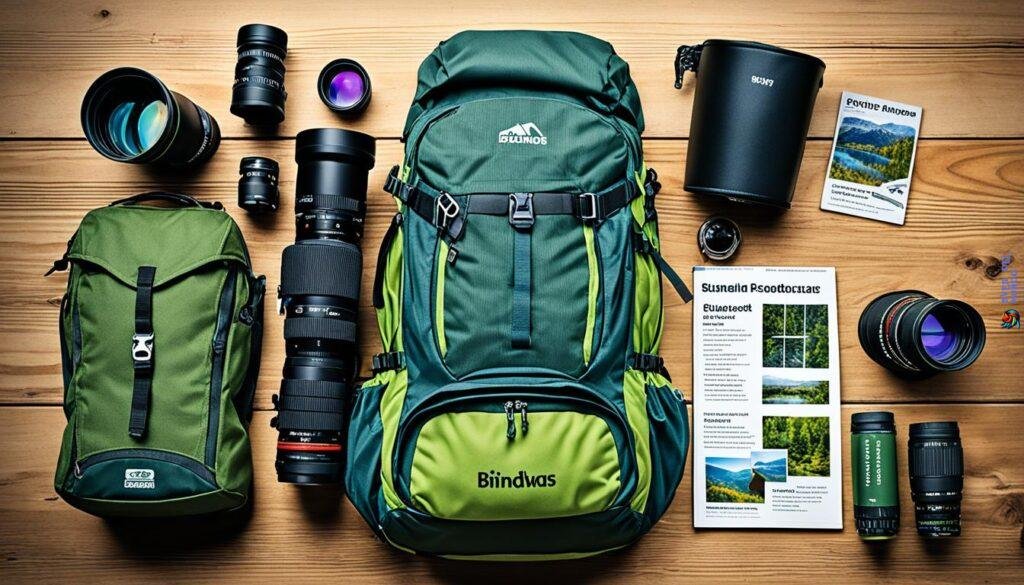
| Category | Binoculars | Spotting Scope | Field Guide/App | Camera | Notebook |
|---|---|---|---|---|---|
| Function | Enhances observation of distant birds | Provides detailed observation of birds | Aids in bird identification | Captures high-quality bird photographs | Records observations and notes |
| Key Features | Magnification power (8x-10x) | Higher magnification for detailed observation | Detailed species information | DSLR/mirrorless camera with telephoto lens | Blank pages for jotting down notes |
| Example Brand | Zeiss Victory SF Binoculars | Swarovski ATX Spotting Scope | Sibley’s Field Guide to Birds | Canon EOS 90D DSLR Camera | Moleskine Classic Notebook |
Finding the Best Birdwatching Locations
Discovering the captivating world of birds requires finding the perfect birdwatching locations. From national parks to coastal areas, these hotspots attract diverse bird species and provide excellent opportunities for observation. Here are some recommendations for finding the best birdwatching locations:
Research Local Hotspots
Start by researching local hotspots in your area. National parks and wildlife reserves are renowned for their rich biodiversity and offer a variety of bird habitats. These protected areas provide a safe haven for birds, making them ideal for birdwatching enthusiasts. Look for parks and reserves that have designated birdwatching trails or guided tours to enhance your experience.
Explore Coastal Areas
Coastal areas are prime locations for birdwatching, particularly during migration seasons. The combination of land and water attracts a wide range of bird species seeking food and shelter. Look for coastal parks, beaches, and estuaries that provide ample opportunities to spot rare and migratory birds. Pay attention to tidal movements, as certain species may be more active during specific times.
Visit Wetlands
Wetlands are another haven for birdwatchers. These lush and diverse ecosystems are home to a variety of bird species, including waterfowl, wading birds, and shorebirds. Look for wetland reserves, marshes, and swamps in your area. These tranquil environments offer unique birdwatching experiences and the chance to observe birds in their natural habitat.
Tip: When visiting birdwatching locations, it’s always a good idea to check local regulations and guidelines to ensure you are respecting the environment and preserving the welfare of the birds.
| Birdwatching Locations | Features |
|---|---|
| National Parks | Diverse habitats, protected areas, guided tours |
| Coastal Areas | Migratory birds, land-water interaction |
| Wetlands | Waterfowl, wading birds, diverse ecosystems |

Tips for Successful Birdwatching
Birdwatching is a rewarding activity that allows you to connect with nature and observe the beauty of birds in their natural habitats. To enhance your birdwatching experience and increase your chances of spotting rare species, it’s important to keep a few tips in mind.
1. Patience is Key
Patience is an essential virtue in birdwatching. Birds can be elusive and may take time to appear. Find a comfortable spot, settle in, and allow yourself to become one with your surroundings. Observe quietly and patiently, giving the birds time to reveal themselves.
2. Hone Your Observation Skills
Being observant is crucial in birdwatching. Pay attention to movement, colors, and patterns in the environment. Use your binoculars or spotting scope to get a closer look at birds in the distance. Develop the ability to recognize different bird species based on their unique physical features.
3. Learn Bird Calls and Songs
Bird calls and songs can provide valuable clues about bird presence and location. Take the time to familiarize yourself with common bird calls in your area. Learning to identify bird sounds can help you locate hidden species and expand your birdwatching repertoire.
4. Understand Bird Behavior
Understanding bird behavior can greatly enhance your birdwatching experience. Birds have distinct feeding and nesting patterns, and by learning about these behaviors, you can anticipate where and when to find them. Study bird field guides or join birdwatching communities to gain insights into bird behavior.
«Birdwatching requires patience and keen observation skills. Be quiet and unobtrusive to avoid scaring away birds. Learn to identify bird calls and songs, as they can help locate hidden species. Understanding bird behavior, such as feeding and nesting patterns, can increase your chances of spotting rare species.»
Remember, birdwatching is not just about sighting rare birds; it’s about appreciating the natural world and the fascinating behaviors of these winged creatures. Enjoy the journey and the tranquility that birdwatching brings.
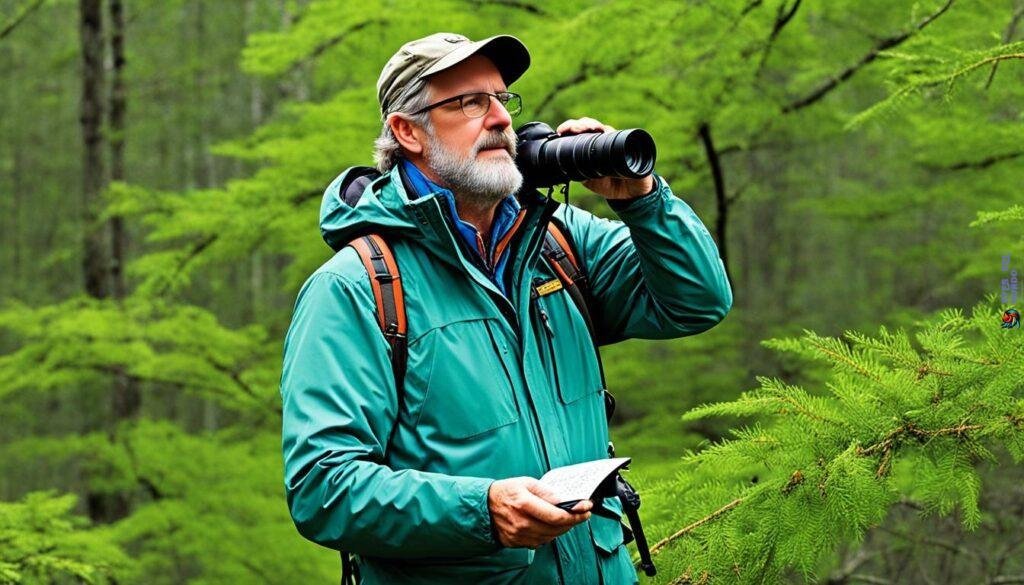
| Essentials for Successful Birdwatching |
|---|
| Binoculars |
| Spotting scope |
| Field guide or birdwatching app |
| Camera |
| Notebook for recording observations |
Rare Birds: How to Spot Them
Spotting rare birds can be an exciting challenge for birdwatchers. These extraordinary avian creatures possess unique physical features or follow specific migratory patterns that set them apart from common bird species. To increase the chances of encountering these rare gems, you need to stay informed and be part of the birdwatching community. Here are some tips to help you spot those elusive birds:
1. Join Birdwatching Communities
Become a part of birdwatching communities and connect with fellow enthusiasts who share their sightings and knowledge. These communities provide valuable information on recent rare bird sightings in different locations. Join online forums and social media groups dedicated to birdwatching to stay updated and collaborate with others.
2. Utilize Birdwatching Apps
Make use of birdwatching apps that provide real-time information about rare bird sightings in specific areas. These apps allow you to track the movement patterns of rare bird species and plan your birdwatching trips accordingly. Some popular birdwatching apps include eBird, Merlin Bird ID, and Audubon Bird Guide.
3. Study Unique Physical Features
Research and familiarize yourself with the unique physical features of rare bird species. Learn about their distinct plumage patterns, beak shapes, or other identifying characteristics. This knowledge will help you differentiate between rare species and their more common counterparts when you spot a bird in the field.
4. Follow Migratory Patterns
Rare bird species often have specific migratory patterns, visiting certain locations during particular seasons. Study the migration routes and timing of these birds to increase your chances of spotting them. Coastal areas, wetlands, and other stopover sites along migration routes are excellent spots to encounter rare migratory species.
5. Keep a List of Target Species
Create a list of rare bird species that you aspire to see. Prioritize your birdwatching trips based on the presence of these species in specific locations. Having a target list will keep you motivated and focused on seeking out these unique birds.
Remember, spotting rare birds requires patience, dedication, and a bit of luck. Enjoy the process and appreciate every bird species you encounter along the way. Happy birdwatching!
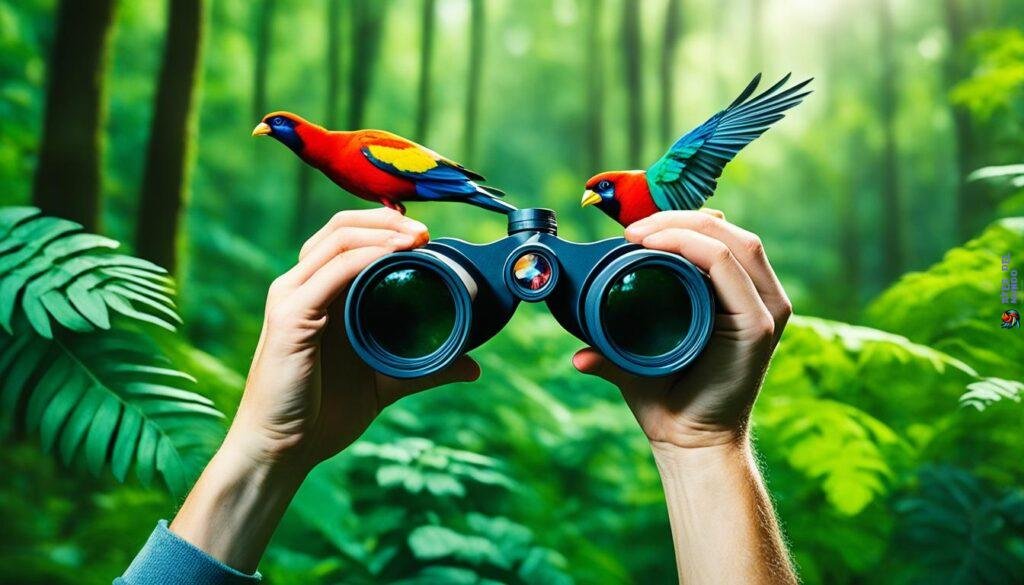
Ethical Birdwatching Practices
When engaging in the wonderful world of birdwatching, it is essential to approach this activity with a deep sense of respect for nature and wildlife. Ethical birdwatching not only ensures the well-being of the birds and their habitats but also contributes to conservation efforts, safeguarding these magnificent creatures for generations to come.
Here are some important practices to consider:
- Maintain a safe distance: When observing birds, it is crucial to maintain a safe distance to avoid causing unnecessary stress. Use binoculars or a spotting scope to observe birds without disturbing their natural behaviors and routines.
- Avoid disturbing nests: Nesting sites are essential for the survival and reproduction of bird species. Never disturb or approach nests, as this can cause great harm to the birds and their eggs or chicks. Respect their privacy and observe from a distance.
- Respect bird habitats: Birds rely on specific habitats to find food, shelter, and breeding grounds. Avoid trampling vegetation, disturbing fragile ecosystems, or damaging their habitats. Stick to designated trails and paths to minimize your impact on their environment.
- Participate in conservation efforts: Get involved in activities aimed at preserving bird habitats and supporting conservation organizations. Join volunteer programs, participate in bird counts, or contribute to citizen science projects. Your efforts can make a significant difference in protecting bird populations and their habitats.
By practicing ethical birdwatching, you not only enhance your own birdwatching experience but also become an advocate for bird conservation. Let’s make sure future generations have the opportunity to marvel at the beauty of birds in their natural habitats.
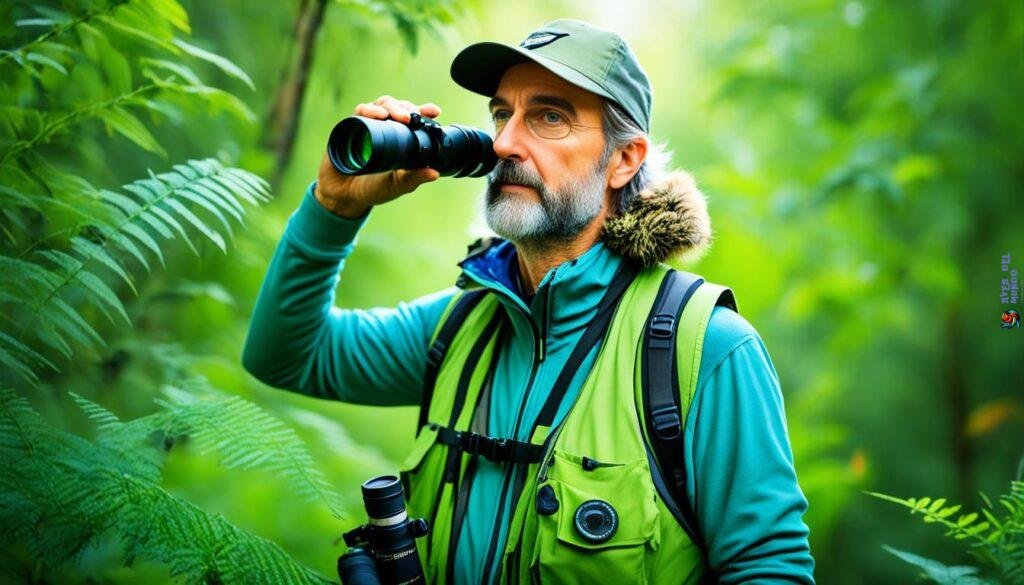

The Joys of Documenting Rare Bird Sightings
Documenting rare bird sightings is not only a fulfilling experience but also plays a crucial role in citizen science and avian conservation efforts. By recording your observations and sharing them with the wider birdwatching community, you contribute valuable data for bird population studies and habitat preservation. Additionally, documenting rare bird sightings allows you to capture beautiful moments with your camera and indulge in the art of bird photography.
Sharing your discoveries with fellow birdwatchers builds a sense of community and inspires others to join in birdwatching and conservation efforts.
When documenting bird sightings, it is important to take detailed notes, including the location, date, and time of the sighting, as well as any unique behaviors or physical features observed. This information becomes invaluable for researchers and scientists studying bird species distribution and migration patterns.
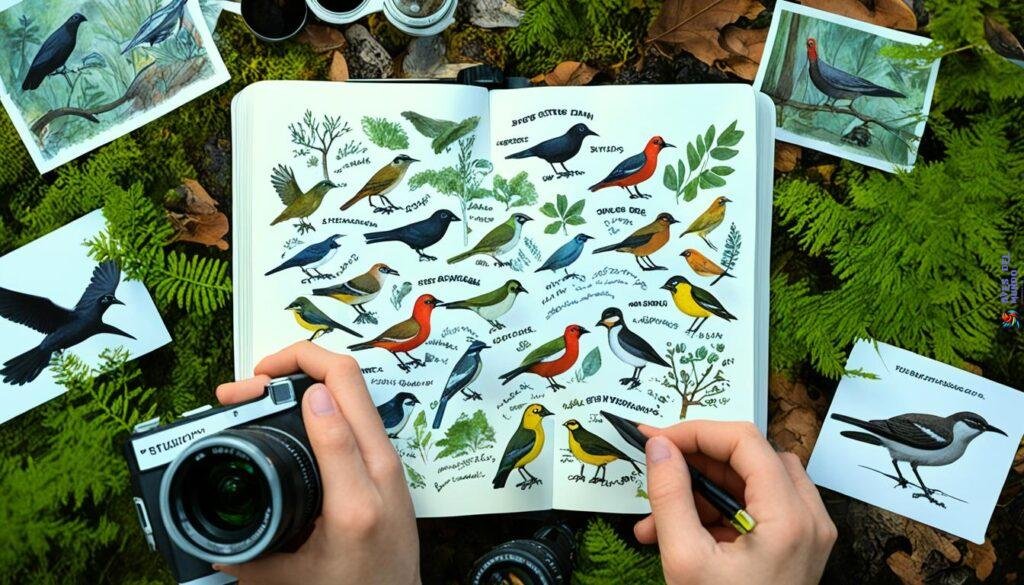
Moreover, the act of documenting rare bird sightings allows you to delve deeper into the fascinating world of ornithology and develop a deeper appreciation for the diverse range of avian species that inhabit our planet.
To encourage others to engage in birdwatching and contribute to citizen science, you can share your documented sightings on birdwatching platforms and social media. This not only showcases your passion but also serves as an educational tool to raise awareness about the importance of bird conservation.
Documenting rare bird sightings is not only about personal enjoyment but also about contributing to the ongoing efforts to understand and protect these magnificent creatures. Your observations matter and can make a difference in preserving bird species for future generations to enjoy.
Benefits of Documenting Rare Bird Sightings:
- Contributes to citizen science and bird population studies
- Supports habitat preservation and conservation efforts
- Allows for the capture of stunning bird photography
- Builds a sense of community among birdwatchers
- Inspires others to take part in birdwatching and conservation
By documenting your rare bird sightings, you become an important part of the collective effort to study, protect, and appreciate our feathered friends. Your observations and photographs serve as a testament to the wonders of avian diversity and inspire others to embark on their own birdwatching adventures.
| Ways to Document Rare Bird Sightings | Advantages |
|---|---|
| Take photographs | Captures visual evidence and aids in species identification |
| Record detailed observations | Allows for accurate documentation of behaviors, locations, and physical characteristics |
| Share sightings on birdwatching platforms | Contribute to citizen science and raise awareness about bird conservation |
Birdwatching Communities and Events
Joining local birdwatching groups or clubs is a great way to connect with like-minded enthusiasts and expand your knowledge of avian species. These communities offer a supportive environment where you can share your passion for birdwatching and learn from fellow enthusiasts. By participating in birdwatching communities and events, you can enhance your skills, discover new birding locations, and contribute to conservation efforts.
Benefits of Joining Birdwatching Communities
When you join a birdwatching club or community, you gain access to a wealth of resources and experiences that will enrich your birdwatching journey. Here are some of the benefits:
- Shared knowledge: Interacting with experienced birdwatchers allows you to learn from their expertise, improving your ability to identify different species and understand their behavior.
- Field trips and events: Birdwatching communities often organize field trips to diverse habitats, giving you the opportunity to explore new locations and observe a variety of bird species.
- Workshops and educational programs: Many birdwatching clubs offer workshops and educational programs conducted by experts. These sessions cover topics such as bird identification, photography techniques, and conservation practices.
By actively participating in these communities, you can broaden your knowledge, connect with fellow birdwatchers, and gain valuable insights into avian conservation efforts.
Exciting Birdwatching Events and Festivals
Birdwatching events and festivals are vibrant gatherings that celebrate the natural beauty of birds. These events provide a platform for birdwatchers of all levels to come together and indulge in their shared love for avian observation. Here are some notable events:
- Bird Counts: Participate in bird counts, such as the Great Backyard Bird Count or the Christmas Bird Count, where birdwatchers record the number and species of birds in a specific area. These counts contribute to important ornithological research and conservation efforts.
- Birdwatching Festivals: Attend birdwatching festivals, like the Cape May Spring Festival or the Biggest Week in American Birding, which offer a range of activities such as guided hikes, lectures, bird banding demonstrations, and photography workshops.
- Guest Speaker Events: Many birdwatching communities invite expert speakers to share their knowledge and experiences. These events provide unique insights into specialized topics such as bird migration, endangered species, or birdwatching techniques.
Attending such events not only enhances your skills as a birdwatcher but also allows you to connect with professional ornithologists, renowned bird photographers, and fellow bird enthusiasts.

Birdwatching communities and events offer a supportive network that fosters learning, community engagement, and conservation efforts. By becoming an active member, you can make lifelong friends, enhance your birdwatching skills, and contribute to the preservation of avian species and their habitats.
Overcoming Challenges in Birdwatching
Birdwatching, like any outdoor activity, comes with its own set of challenges. Unpredictable weather conditions and days with fewer bird sightings can make your birdwatching experience more challenging. However, these challenges should not deter you from pursuing your passion.
Instead, embrace these moments as opportunities for growth and improvement. Use them to further develop your skills and deepen your appreciation for the natural world. Remember, every day spent birdwatching is a chance to learn something new.
Continuous learning is key to becoming a better birdwatcher. Seek guidance from experienced birdwatchers and consult field guides to enhance your knowledge. Stay updated with the latest research and techniques, as there is always something new to discover in the world of birdwatching. By embracing the challenges and continuously learning, you can take your birdwatching abilities to new heights.
So, the next time you encounter challenging weather conditions or a day with fewer bird sightings, don’t get disheartened. Instead, view it as an opportunity to test your skills, expand your knowledge, and adapt to the unpredictability of the natural world. Remember, in birdwatching, the journey is just as important as the destination.


